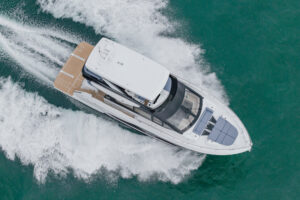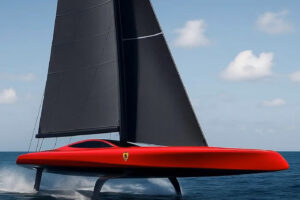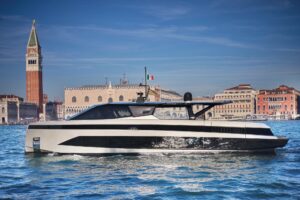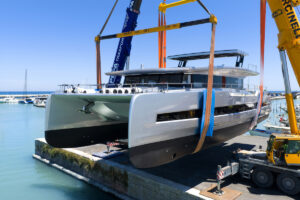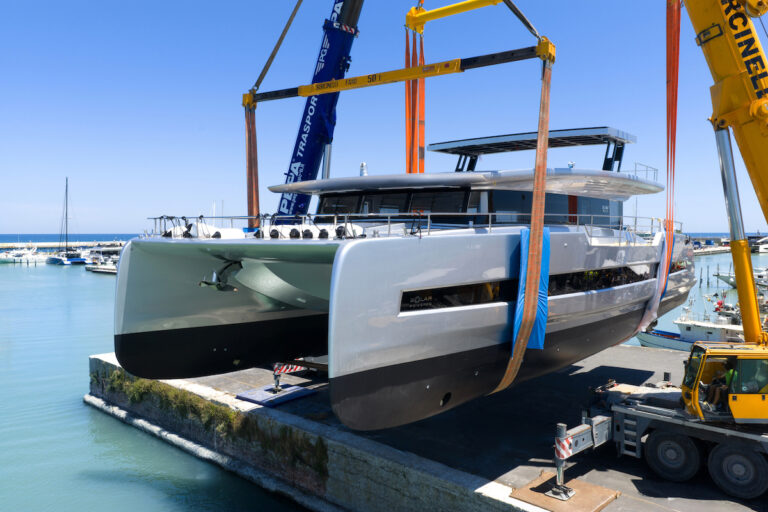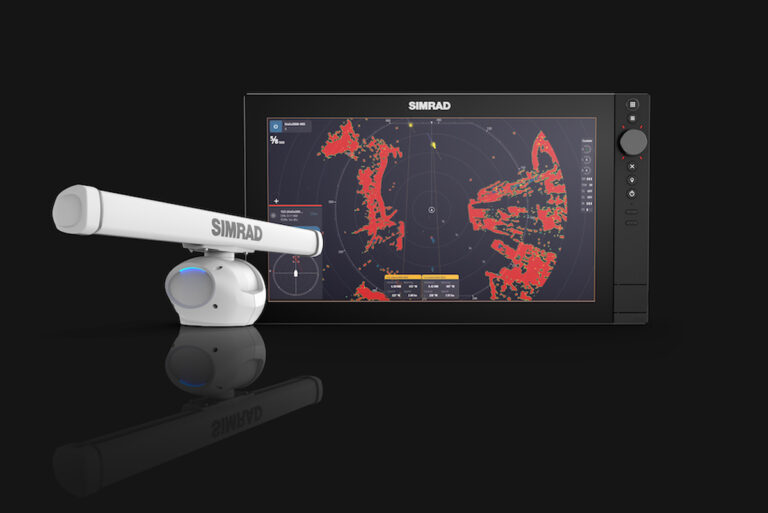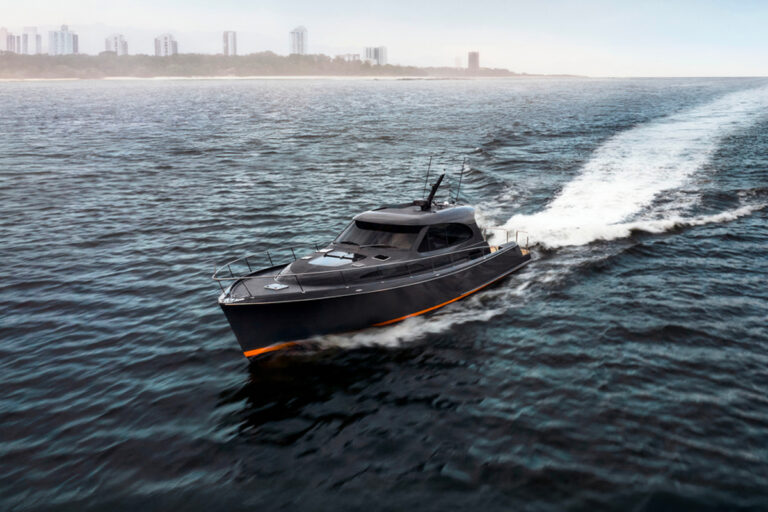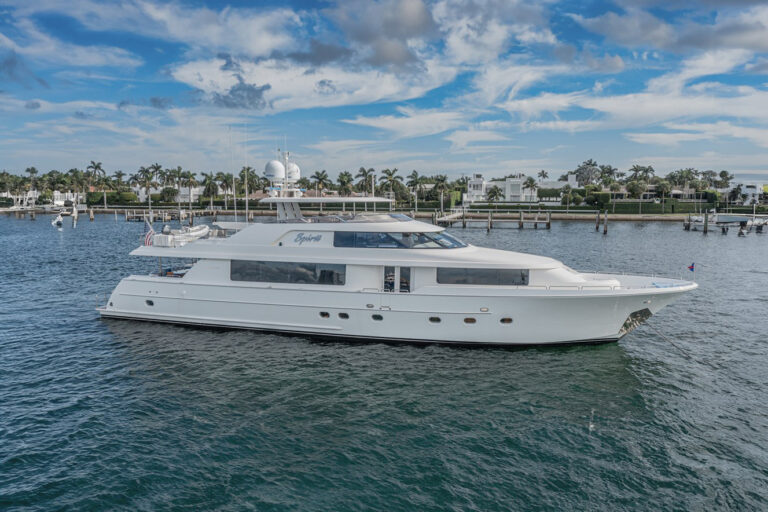Symbol Yachts has always followed a different drummer. Founded in 1982, a time when Taiwan was turning heads with teak-trimmed sailing yachts and trawlers, Symbol focused on virtually wood-free, planing hull designs. These days, the active market for larger semi-production motoryachts is consuming Symbol’s attention.
Recently I inspected the yard’s largest creation at its largest dealer-Heart Marine-in Ft. Lauderdale, Florida. Heart Marine has been a driving force behind the increasing scale of Symbol’s offerings and played a significant role in the design of the 880-a role they’re justifiably proud of. “Building yachts this size in Taiwan was little more than a dream 20 years ago; today Taiwan is a major player in the 70- to 90-foot market, said Heart Marine’s vice president, Barin Cardenas.
Yacht designer Jack Sarin has worked with Symbol since 2001 and today most of the builder’s line bears his signature blend of proven performance and contemporary American styling. This, coupled with pricing that is more than competitive with European and American offerings, has allowed Symbol to carve out its own niche in the market.
While Sarin’s influence is evident in the 880’s design, she was born on the drawing boards at the shipyard. “We developed the basic design for the 21-foot beam, 80/88-foot series, and asked Jack to review the project, said Cardenas.Once Sarin was brought in, he took responsibility for tweaking the styling and the hull form, as well as engineering the structure and calculating the weights and balance.
Cardenas served as project manager and, while there were specific goals in creating the design, Heart Marine’s first customer for the 880 played a significant role in defining her styling and interior arrangement. Cardenas worked directly with the owner and his family, communicating long distance with drawings and photos from Heart Marine’s Ft. Lauderdale office and the shipyard. “The Internet has made my job easier, said Cardenas.
Cardenas visited the yard half a dozen times during the course of the project and when he was not on-site he received photo updates and reports online. While she is not classed, the American Bureau of Shipping (ABS) was contracted to inspect the 880’s construction. As is often the case with boats built in Taiwan, systems design is in accordance with ABYC (American Boat & Yacht Council) standards. “Familiar plumbing, wiring and mechanical components, that can be easily serviced or replaced in the United States, reduce warranty headaches and help us keep our customers on the water, said Cardenas.
Symbol’s two production facilities are located in the Kaohsiung Industrial District. The yard’s workforce, that now numbers more than 150, has matured with the Taiwanese yacht-building industry. Today, a second generation of craftsmen is raising the bar in terms of the capability and quality. While sculpting intricate wood interiors has long been something of a Taiwanese trademark, their work with fiberglass and stainless steel deserves equal billing.
The 880 is built in female tooling with a blend of stitched and woven reinforcements and polyester resin. The hull bottom is solid fiberglass supported by a network of fiberglass stringers, plywood bulkheads and web frames. Foam coring is used to stiffen the topsides, decks and superstructure. Exterior surfaces are finished in gelcoat. Fuel tanks are built of fiberglass, which is a plus in my view and somewhat unusual as aluminum tanks are more common on boats built in this region. While fixed tooling is used to build the superstructure, it can be modified to create different styling effects.
Hull number one’s interior is finished in high-gloss cherry, accented with leather soft goods and high-quality, European hardware and fixtures. Other woods and finishes are offered as part of the standard package. Heart Marine’s contract includes an allowance that covers interior design and décor. Arrangements and décor are tailored to each client’s specifications.
As hull number one’s owner has a large family and enjoys extended cruising, the 880’s large main cabin and pilothouse-forward design were well suited to his needs. She is laid out with a saloon and full-service bar aft. An enclosed galley is amidships, adjacent to a family-style dining/game room area that can be closed off with a sliding tambour bulkhead. An adjoining day head has a full shower. An afterdeck seating area is designed for dining alfresco.
The business-like pilothouse is segregated from the public areas by a bulkhead and is designed for professional crew-not sightseeing. Side decks allow easy movement fore and aft. Stairs lead from the afterdeck to the swim platform and a sunning area at the bow is equipped with a whirlpool bath. Exterior decks are covered with Flexiteek–a low-maintenance teak alternative that is durable, sure-footed and almost looks like the real thing.
The bridge is accessible from the afterdeck or the main cabin and has a fiberglass hardtop that provides protection from the sun. There is a full helm station as well as a lounge/exterior dining area with a full-service bar. A barbeque and top-loading freezer are hidden in the cabinetwork. For getting-around needs, a Novurania 460 DL tender is carried aft on the boat deck and a personal watercraft is carried on a transom lift.
The owner and guest accommodations are below deck, forward of the machinery space. The full-beam master stateroom has a walk-in closet and a head with a shower/ steam room. The forward cabin has a queen island berth and a private head. Two additional staterooms have private heads and single berths that convert to queens as well as Pullman-style berths. Crew’s quarters for four are aft of the machinery space and include two cabins, a head/shower and a storage area. The crew and machinery spaces are accessible from the platform or the afterdeck–the latter would be a better bet while under way or in inclement weather.
Hull number one is equipped with a pair of 1,400 hp Caterpillar 3412-E’s. During Heart Marine’s sea trials, a maximum speed of 20.5 knots at 2300 rpm and a cruising speed of 19 knots at 2100 rpm were recorded. Cardenas predicts a range of approximately 850 nautical miles at 11.8 knots. While not standard, Wesmar stabilizers were fitted and seem a worthwhile investment for a boat of this size and speed. A Wesmar bow thruster is included. Future boats will be powered with the 1,550 hp Caterpillar C30’s, which Cardenas expects will add several knots to the top-end and cruising speed. He also suggests that a new driveline design will result in a draft of five feet, six inches-a plus for those who wander the skinny waters of the Bahamas.
It takes about 11 months to build an 880. Base price with the 1,550 hp Caterpillar C30’s and a long list of standard features is approximately $3,500,000. All up, with tender and electronics, plan on spending around $4,000,000. While this is certainly a good value, Cardenas feels that it is not price alone that is attracting yachtsmen to Taiwan and the Symbol brand. “We have always encouraged our customers to be creative-even with our smaller designs. There are few production builders outside of this region that can afford to offer this sort of flexibility. If you feel creative, Symbol’s semi-production program and the 880 are worth a look.
Contact: Heart Marine, (800) 457-7888; (954) 463-0101; fax (954) 463-0202; www.heartmarine.com.

